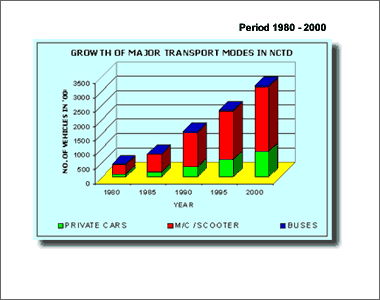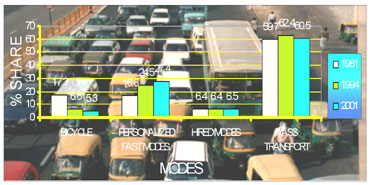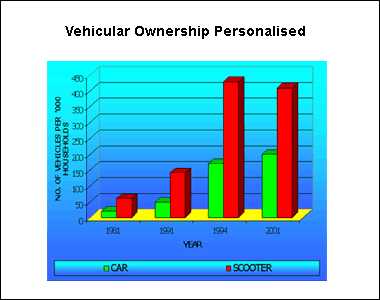|
|
 |
|
| |
|
Master Plan of
Delhi (MPD) 2021 | 2001
| 1962
Traffic & Transportation
Present Scenario
Growth in number of Vehicles
- In 2000, total number of vehicles in NCTD are 34.80 lacs.
- Total number of vehicles in Delhi are more than the combined no. of
vehicles in other 3 Major Metros in the country.
- Cars increased by 6.3 times,
- 2-W increased by 5.2 times,
- Buses increased by 3.6 times

(Source : RITES Report)
Road Length
- Total road length in NCTD has increased from 15000 KM in 1981 to 23000
KM in 1993 & 26000 KM in 2000.
- Number of vehicles per KM has increased from 37 in 1981 to 134 in
2000 (Four Fold increase).

(Source : RITES Report)
Modal Split
- Rites survey indicates rise in the vehicular trips by personalised
fast modes from 16.6% in 1981 to 27.4% in 2001.
- Vehicular trips by bus has marginally increased from 59 .7 % in 1981 to 60.5% in 2001.

(Source : RITES Report)
Vehicular Ownership
- Car ownership per 1000 households has increased by 10 times from 20
cars in 1981 to 200 cars in 2001.
Vehicular
Ownership (Personalised)

(Source : RITES Report)
- Car ownership per 1000 households has increased 10 times from 20 cars
in 1981 to 200 cars in 2001
- 2-W ownership per 1000 households has increased 7 times from 60 in
1981 t0 410 in 2001.
Distribution of Vehicular trips in NCTD

(Source : RITES Report)
- Around 83% are intra-city trips.
- Multi-nodal landuse pattern of Delhi generates large number of intra-city
trips due to increased use of personal modes of transport.
Issues : Transportation
- Major transport corridors will have intensive land utilization - travel
by public transport to increase.
- Introduction of MRTS to alter travel characteristics in the city.
- Utilization and Integration of ring rail system with the
city transport network.
- Non implementation of landuse restructuring of Land use along ring rail and proper
feeder services.
- Partial access control on ring road and outer ring road.
- Identification of new / alternate road alignements to reduce traffic
congestion on the existing routes as Urban Relief Roads & passing relief points.
- Out of four proposed directional metropolitan passenger terminalsby MPD 2001 East Delhi
only one is partly functional i.e. Anand Vihar.
- One truck terminal on G.T. Road (NH-1) is functional remaining three
are yet to be developed.
| Critical Issues : |
Impact of MRTS on city transportation Network and land uses |
- Major impact of MRTS on the city structure as well as landuse along
the MRTS corridors. Basic idea is to shift more personal vehicular
trips to MRTS and make roads comparatively less congested.
- Average trip length by road based modes is approx. 10-11 km. It
is expected that at the first instance bus trips with 'longer trip
length' would shift to MRTS. Due to development of economic corridors
along MRTS, personalized vehicular trips will shift to MRTS gradually
.
|
|
|
 |
|
 |
|




